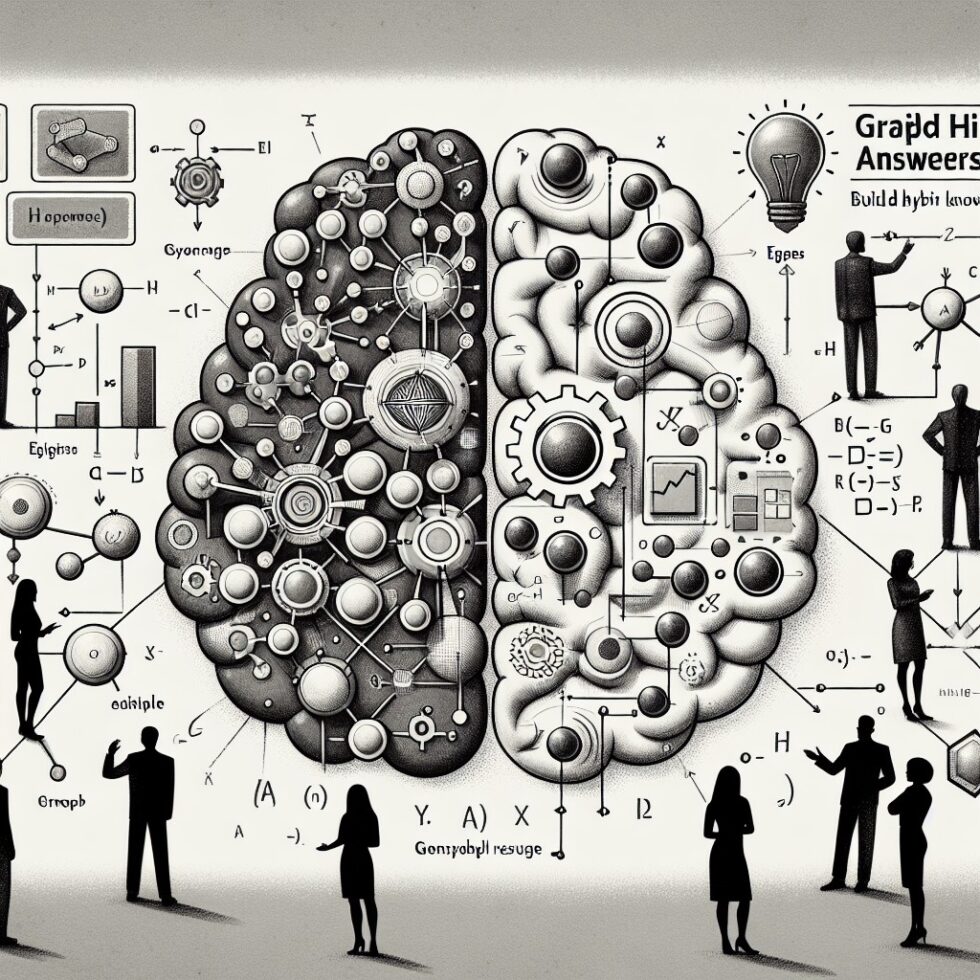
Why Hybrid Retrieval Beats Plain Text Search
Many teams add a retrieval layer to large language models and call it done. It works for simple lookups, but it cracks under pressure. Ask a model to reconcile two conflicting documents, trace an answer back to its sources, or chain together several facts, and a pure vector search often falls short. That is where a hybrid approach—Graph‑RAG—shines.
Graph‑RAG combines a knowledge graph with vector and keyword retrieval. The graph gives you structure: entities, relationships, and constraints. Vectors bring flexible semantic match to catch synonyms and fuzzy wording. Together they deliver grounded answers that are easier to check, more resilient to prompt changes, and better at multi‑step reasoning.
This article walks through how to design, build, and run a Graph‑RAG system. We will focus on clear steps, practical trade‑offs, and patterns you can use today without rebuilding your entire stack.
What Graph‑RAG Actually Adds
A knowledge graph is a network of nodes (people, products, places, policies) connected by edges (works_for, part_of, supplies, contradicts). In Graph‑RAG, you use the graph to target relevant facts, then fetch supporting passages from source documents for the model’s context window. The LLM does not have to invent a chain of logic; your graph supplies it.
- Multi‑hop queries: Instead of asking a model to infer a path across three documents, you query the graph to find the path, then feed the supporting text for each hop.
- Conflict handling: Attach provenance, timestamps, and trust scores to edges. The graph can surface conflicting claims so the model can present them explicitly.
- Explainability: You can show the subgraph that led to an answer and the exact citations used—no hand‑waving.
- Consistency checks: Simple constraints (e.g., one CEO per company at a time) help catch contradictions before they reach the model.
Design Your Graph First, Not Your Prompts
Prompting matters, but structure composes better than clever phrasing. Start by sketching the smallest graph that can answer your common questions, and grow from there.
Start with a tight schema
List your top 20 question types. For each, name the entities and relationships you need. Keep it simple—prefer a short, explicit vocabulary over dozens of edge types you will not maintain.
- Entities: Company, Product, Contract, Policy, Person, Location, Regulation
- Relationships: owns, supplies, regulates, contradicts, supersedes, cites, similar_to
- Attributes: effective_date, source_url, confidence, jurisdiction, version_id
When possible, align with public vocabularies. Schema.org types for products and organizations, or industry‑specific terms, will save you time and improve interoperability.
Model provenance as a first‑class citizen
For every node and edge, store where it came from, when it was extracted, and how confident you are. Use a consistent provenance schema so you can filter later. You might attach:
- Source: URL, file path, repository, collection
- Time: publication date, capture time, effective period
- Method: hand‑curated, rule‑based extraction, ML extraction, model name and version
- Trust: numeric score or discrete class (internal record > official filing > third‑party blog)
Provenance lets you do more than cite. You can bias retrieval toward trustworthy edges, quarantine low‑trust ones, and show the user how confident the system is.
Decide on constraints early
Lightweight constraints reduce contradictions. Examples:
- Cardinality: one CEO_of per company per effective date
- Type constraints: only a Person can be CEO_of a Company
- Temporal rules: supersedes must point to an older record
Constraints can be enforced at write time in your graph database, or checked in a nightly validation job. Either way, they pay for themselves by catching errors before they show up in answers.
Ingest and Build the Graph
Your pipeline will pull from documents, logs, APIs, and databases. Aim for a clear separation between extraction (turning text into candidate facts) and grounding (resolving entities and storing final triples with provenance).
Extract candidate facts
You can get far with a mixed approach:
- Rules: Regex, basic NLP, and known patterns for things like SKUs, addresses, or policy headers
- Models: Named entity recognition (NER), relation extraction, and table/section parsers
- LLMs: Structured prompts that return JSON triples with soft confidence scores
Keep the extraction layer pluggable so you can swap models as better ones arrive. Store raw extractions in a staging area with full text snippets. Do not insert into the main graph yet.
Resolve entities before you connect them
Entity resolution is where many projects bog down. You need to unify “Acme, Inc.” in three different formats into one Company node, without mixing it up with “Acme Holdings.”
- Blocking: Reduce comparisons using coarse keys (domain, tax ID, exact name match, city+state)
- Scoring: Combine features (name similarity, address distance, shared IDs, website, email domains)
- Thresholds: Use high/low cutoffs for auto‑match, manual review, or reject
- Feedback: Keep a labeled set of resolved and rejected pairs to retrain matchers
Write resolved entities to the graph with a stable ID. Keep aliases as properties for searchability. Unresolved items can still live in the graph with a candidate_of relationship and lower trust.
Insert edges with care
Edges carry meaning. Enforce type constraints, attach provenance, and apply temporal logic on write. For claims that change over time, keep multiple edges with validity intervals rather than overwriting.
It is useful to maintain a contradicts edge when two sources claim conflicting facts. Store both, and let downstream retrieval surface the conflict with context. This is more honest than picking a winner too early.
Index text alongside the graph
Keep embeddings and keyword indexes for relevant fields and source passages. You are not abandoning vectors—you are using them to find the right subgraph and sources.
- Entity and relation descriptions: embed names, aliases, and summaries
- Passage windows: chunk source documents with overlap, store embeddings and offsets
- Attribute texts: product specs, policy clauses, contract clauses
Retrieval: From Question to Subgraph to Context
At query time, you want a small, relevant subgraph and the minimal supporting text that explains each hop. That keeps latency low and improves answer quality.
Stage 1: Understand the query
- Classify intent: factual, comparison, timeline, policy lookup, “how‑to,” or anomaly detection
- Extract entities: use NER and alias tables to link names to graph nodes
- Detect constraints: time windows, jurisdictions, product lines
Even a simple intent classifier can route retrieval: timeline questions need temporal edges; comparisons need sibling relationships; policy lookups need exact clause citations.
Stage 2: Pull a subgraph
- Neighborhood crawl: Start at identified entities and expand 1–3 hops along allowed edge types
- Graph filters: prune by time, jurisdiction, or trust thresholds
- Path search: find the shortest path or k best paths between entities
- Community/cluster detection: group related entities to avoid scattershot expansions
Persist common subgraphs in a cache keyed by query templates: “Company → Supplier → Component → Regulation” patterns repeat. Precomputing them reduces latency.
Stage 3: Fetch supporting passages
For each node/edge in the subgraph, fetch the best passages to cite:
- Join the node/edge to its source_url and stored offsets
- Rerank passages by semantic similarity to the query and graph context
- Deduplicate near‑identical snippets to save tokens
At this point you have a compact subgraph plus citations. Merge them into a model‑friendly bundle.
Stage 4: Compose the context
Keep the context format predictable. Use a short header with instructions, then facts and citations. Example layout:
- Instruction: “Answer concisely. If sources disagree, list the viewpoints with citations.”
- Facts: triplets like “Acme owns Beta (effective: 2022‑05‑01) [S1]”
- Paths: “Acme → supplies → Gamma → used_in → Delta [S2, S3]”
- Citations: numbered references with URLs and short quotes
By giving the model structured facts first, you help it stay grounded. The supporting passages let it quote naturally without hallucinating.
Prompting Patterns That Work
Prompting is simpler when the retrieval is strong. A few patterns help:
- Checklist prompts: “Use only the facts above. Confirm date, source, and constraints before answering.”
- Conflict‑aware prompts: “If facts conflict, present both and explain the difference in effective dates or sources.”
- Sanity checks: “If you cannot find all required facts, say what’s missing and suggest the next graph query.”
Avoid burying instructions in long prose. Short, bold directives plus structured facts beat flowery prompt engineering.
Evaluate Answers Like a Product, Not a Demo
Measure what matters to your users, not just benchmark scores. Consider three layers of evaluation.
Retrieval quality
- Hit rate: percent of ground‑truth facts present in the retrieved subgraph
- Noise: irrelevant facts included
- Latency: time to assemble subgraph and passages
Answer quality
- Factuality: does each claim map to a cited fact?
- Completeness: for multi‑step questions, did the answer cover all steps?
- Source coverage: are top‑trust sources represented?
Explainability and trust
- Traceability: can users click through to sources?
- Conflict presentation: are disagreements clearly labeled?
- User confidence: short survey scores after answers (use a 5‑point scale)
For teams with ground‑truth datasets, back‑test new extraction models and schema changes. For others, start with manual review and targeted A/B tests on high‑value question sets.
Control Latency and Cost
Graph‑RAG can be fast if you design for it. The bulk of delay often sits in redundant expansions and oversized context windows.
- Cache subgraphs: Most questions repeat patterns. Hash on (entity IDs, edge type set, filters).
- Limit hops: Default to 2 hops and allow 3 only for certain intents.
- Pre‑summarize clusters: Maintain short summaries per node and relation type to cut token use.
- Rerank early: Reduce candidate passages before hitting the LLM.
- Streaming answers: Return citations first, then the narrative as it arrives.
Keep It Fresh Without Breaking Consistency
Real data changes. Contracts renew, products ship, org charts reshape. You want freshness without random churn in answers.
- Incremental upserts: Process new documents into the staging store, then merge deltas after entity resolution.
- Versioning: Tag nodes/edges with version_id and validity intervals; never silently overwrite.
- Staleness flags: For old facts, surface a gentle note: “Policy may be superseded; last verified 9 months ago.”
- Change tests: Re‑run key questions after major ingest to detect shifts in answers.
Security and Governance Basics
Users trust answers they can verify. They also expect responsible handling of their data. A few controls go a long way:
- Access control: Filter the graph by user permissions before retrieval—do not rely on post‑filtering text.
- Redaction on retrieval: Mask sensitive attributes in the context pack, not just in UI.
- Audit trails: Log subgraphs and sources used per answer. This helps debugging and compliance.
- Source integrity: Track origin and license. Avoid mixing proprietary content into public outputs.
Use Cases You Can Ship
Graph‑RAG is not just for academic questions. It unlocks practical wins:
- Customer support: Connect products, versions, known issues, and fixes. Answers cite release notes and tickets.
- Compliance Q&A: Tie policies to clauses, exceptions, and effective dates. Show both rule and exemption with citations.
- Supplier due diligence: Map companies, beneficial owners, regions, and sanctions lists. Conflicts are explicit.
- Product discovery: Link components, compatibility, and certifications. Compare items with structured facts.
- Research curation: Relate papers, methods, datasets, and results. Trace claims across citations and replications.
A Minimal Stack That Works
You do not need exotic infrastructure to get started.
- Graph store: Neo4j, ArangoDB, JanusGraph, or a lightweight in‑memory graph for prototypes
- Indexing: An embedding DB (e.g., FAISS or a cloud vector store) plus a keyword index (e.g., Elasticsearch)
- Extraction: A mix of rules, open NER/RE models, and LLM prompts with JSON output and confidence
- Orchestration: A simple queue for ingest, and a retrieval service that assembles subgraphs and contexts
- LLM: Any capable model with deterministic settings for retrieval summaries and narrative answers
Focus on the glue logic: entity resolution, schema discipline, and how you compose the context. This is where accuracy is won.
Troubleshooting: What Breaks and How to Fix It
Symptoms: Vague answers and token bloat
- Cause: Over‑expanding the graph and stuffing too many passages
- Fix: Tighten intent routing, reduce default hop count, pre‑summarize node neighborhoods
Symptoms: Contradictory claims in the same answer
- Cause: Missing temporal logic or trust weighting
- Fix: Enforce effective date windows, prefer higher‑trust edges, prompt with “present disagreements” pattern
Symptoms: “Ghost entities” and duplicates
- Cause: Loose entity resolution thresholds
- Fix: Improve blocking keys, add features (website, IDs), require human review for borderline merges
Symptoms: Slow answers on multi‑step questions
- Cause: Path search across a large graph at query time
- Fix: Precompute frequent path motifs, cache subgraphs, and cap path search depth by intent
Symptoms: Users do not trust the system
- Cause: Missing or weak citations, opaque logic
- Fix: Show the subgraph, list sources with short quotes, add a “why these sources” note with trust levels
Going Further: Pattern Libraries for Graph‑RAG
As your graph matures, you can add patterns that compress complexity into reusable blocks.
- Rule bundles: Per domain, bundle allowed edge types, default filters, and prompt templates.
- Subgraph functions: “Explain relation X between A and B” becomes a stored procedure that returns facts and citations.
- Confidence bands: Present answers with “high confidence/medium/low” sections, driven by provenance and agreement across sources.
- Counterfactual checks: Run a second retrieval that tries to disconfirm the top claim. If it finds strong contradictory evidence, surface it.
Team Operating Notes
Graph‑RAG is not a one‑and‑done project. A small set of rhythms keeps it healthy.
- Weekly schema reviews: Add types sparingly. Remove or merge unused ones.
- Extraction scorecards: Track precision/recall on a labeled set. Ship model updates with diffs on key questions.
- Answer clinics: Review 20 random answers with product, legal, and support. Capture failure modes.
- Deprecation policy: When you change edge semantics, version them. Migrate old edges with scripts and rollbacks.
What Not to Overbuild
It is tempting to design a perfect ontology or boil the ocean on entity resolution. You do not need that to deliver value.
- Start narrow: Cover the top question types with a minimal schema.
- Accept ambiguity: Keep “candidate” edges with lower trust where needed. Do not block ingest because of perfectionism.
- Ship explainability: A smaller, transparent system beats a larger opaque one for user trust.
A Short Example to Make It Concrete
Suppose your support team fields this question: “Does product Delta work with the new Gamma module in EU deployments, and are there any special steps?”
A Graph‑RAG pipeline might do the following:
- Intent: compatibility + regional policy lookup
- Entities: Product: Delta, Module: Gamma, Region: EU
- Subgraph: Delta —compatible_with→ Gamma; Gamma —requires→ Firmware ≥ 3.2; EU —policy→ Data export step; Delta —supersedes→ Delta v1.2
- Passages: Release notes excerpt for compatibility; deployment guide for EU step; firmware table snippet
- Context: Structured facts with citations; short instruction: “If any step is region‑specific, call it out.”
- Answer: Concise steps with numbered citations; a note: “Delta v1.2 is superseded—use v1.3+.”
Because the graph connects compatibility, version requirements, and regional policies, the model does not guess. It assembles the known pieces and cites them.
The Payoff
Graph‑RAG is not about exotic algorithms. It is about adding structure where it matters and letting the model narrate from solid ground. You get fewer hallucinations, clearer answers, and a paper trail that holds up to scrutiny. Your users notice the difference the first time they click a citation and see exactly where a claim comes from.
Summary:
- Graph‑RAG combines knowledge graphs with vector and keyword retrieval to deliver grounded, explainable answers.
- Start with a tight schema, model provenance and constraints, and keep extraction pluggable.
- At query time, assemble a small subgraph, fetch focused passages, and compose a predictable context.
- Use intent routing, controlled hops, caching, and pre‑summaries to keep latency and cost in check.
- Evaluate retrieval and answers with practical metrics: hit rate, factuality, completeness, and traceability.
- Maintain the system with weekly schema reviews, labeled extraction tests, and answer clinics.
- Ship narrow, transparent solutions first; expand your graph as real questions demand.





